HTC One S Review - International and T-Mobile
by Brian Klug on July 17, 2012 9:30 AM ESTCellular
The HTC One S includes Qualcomm’s MSM8260A SoC, which in turn corresponds to air interface support up to DC-HSPA+ Category 24 (two WCDMA carriers with 64QAM) for a max data rate of 42 Mbps. The difference between this and MSM8960 is obviously the lack of LTE, and lack of CDMA2000 1x/EVDO support which is in MSM8660A (but includes no DC-HSPA+). For T-Mobile, having another DC-HSPA+ phone is an obvious plus, and as we’ll show in a minute results in pretty impressive speeds. The previous DC-HSPA+ platform that T-Mobile deployed was the so-called “SoC Fusion” combination, which consisted of APQ8060 and MDM8220, in devices like the T-Mobile SGS2. International customers, I believe, will get DC-HSPA+ if their carrier has made the correct network and user provisions for it.
For those that aren’t familiar, DC-HSPA+ Category 24 (3GPP Rel.8) employs carrier aggregation in addition to the other HSPA+ features from Release 7. Essentially, two 5 MHz WCDMA carriers are aggregated together on the downlink, resulting in roughly double the performance of a single WCDMA carrier situation. Note that the uplink remains single carrier, so there’s even more of an asymmetry that happens, but given the traffic asymmetry that already exists for most mobile workloads this isn’t a huge deal. When you consider that most LTE deployments in the US are currently at maximum 10 MHz FDD, you can see the roots of T-Mobile’s DC-HSPA+ as “4G” argument. Of course, that is a vast oversimplification, as WCDMA and LTE differ massively in other fundamental ways such as multiplexing scheme (CDMA vs OFDMA) and other features (MIMO, flat IP PS, etc.).
The International and T-Mobile One S differ in what UMTS bands are supported, as the International One S targets both Asia and Europe, while the T-Mobile version goes for the Americas. I’ve made a table with the pertinent information.
| HTC One S - Network Support | |||||
| GSM/EDGE Support | 850 / 900 / 1800 / 1900 MHz | ||||
|
WCDMA Support One S - International |
850 / 900 / 2100 MHz | ||||
|
WCDMA Support One S - T-Mobile |
850 / 1700 / 1900 / 2100 MHz | ||||
| HSPA Speeds | HSDPA 42.2 (Cat.24) / HSUPA 5.76 (Cat.6) | ||||
| Baseband Hardware | Qualcomm MSM8260A | ||||
What’s awesome about the T-Mobile HTC One S is that it supports 2100 MHz UMTS Band I and AWS alongside Cellular 850 MHz and PCS 1900 MHz. The result is that if you either can find one unlocked, or unlock your T-Mobile One S, you get a quad-band phone which supports DC-HSPA+. I managed to get T-Mobile to unlock my One S, and had no issue using it on AT&T. If anything, I wish AT&T would carry a device like this, since I find the smaller form factor very appealing.
The transmit antenna for the One S is at the bottom in the plastic region, and up on the removable part is another diversity receive path.
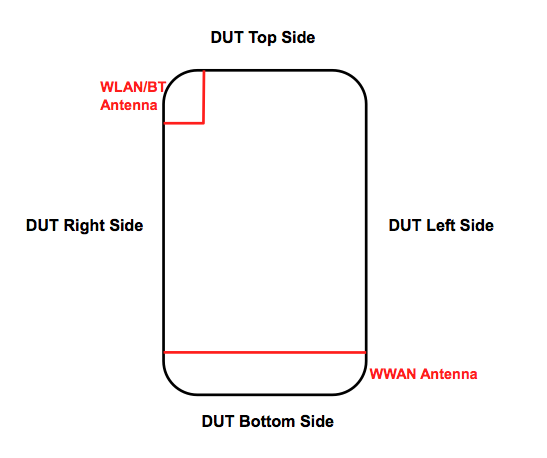
This is our second time showing some DC-HSPA+ results, the first time was in the T-Mobile SGS3. To test, I used the same workflow as always, essentially running as many tests as possible using Ookla’s speedtest.net application on Android, exporting the results, and making some pretty graphs with python.
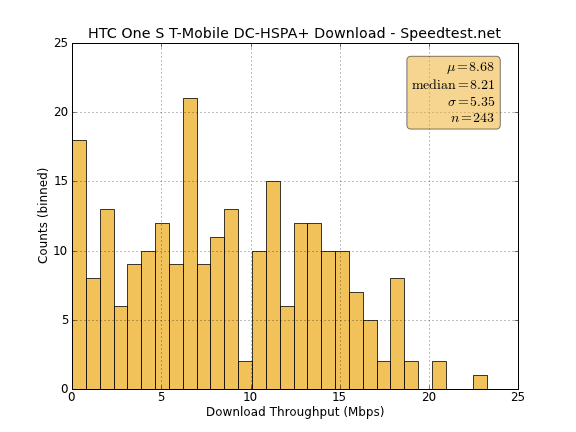
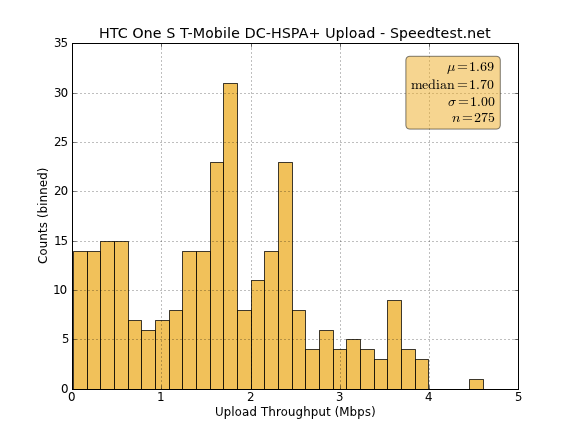
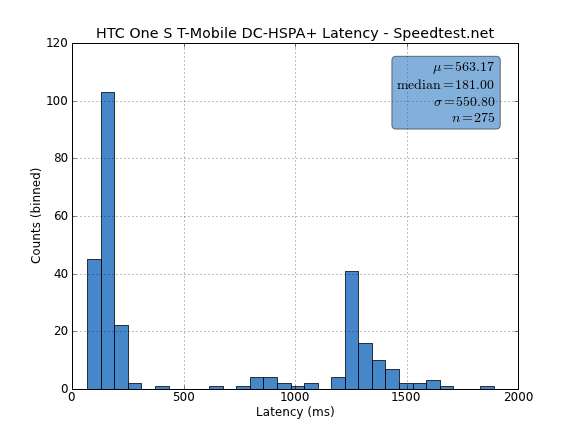
Unsurprisingly DC-HSPA+ is impressively fast on the downlink, with an average of around 9 Mbps and a maximum of just above 20 Mbps. It’s not the kind of performance you’ll get out of LTE (proving that the many subcarrier scheme employed in OFDMA and other enhancements to the physical layer in LTE does in fact pay off), but it’s pretty darn impressive nonetheless. There’s a weird double distribution in latency probably due to setup time coming out of CELL_PCH and setting up the DC-HSPA+ link. Running a test right after this setup yields much lower latency, which is why I say it seems to be connection setup related. I have to say that I’m impressed with how fast T-Mobile’s DC-HSPA+ is in my area, and that DC-HSPA+ isn’t a bad interim air interface until the carrier can deploy LTE. I have a lot of respect for how fast T-Mobile deploys WCDMA related updates.
On the international One S, my only option for testing was AT&T in an 850 MHz market in Pinal County north of me (I'm in Tucson, AZ from Pima county just south, where AT&T is only PCS 1900 MHz). I actually ended up driving over 400 miles and sleeping in a number of different hotel rooms (many Bothans died... and so forth) to finish battery life and speed testing on the International One S because it's the only county in Arizona where AT&T holds an 850 MHz license.
There the phone posted speeds that are more in line with what I expected for single carrier AT&T HSPA+. Running these was more of an exercise in making sure everything was working fine rather than proving something about the One S or AT&T. Those battery life numbers earlier on and seeing what experimental differences come from operating the Rx low noise amplifier in a 10 MHz wide configuration were the real effort. Note that the big power consumer, the Tx power amplifier, which is active when in CELL_DCH and CELL_FACH, is still just 5 MHz because DC-HSPA+ only affects the downlink.
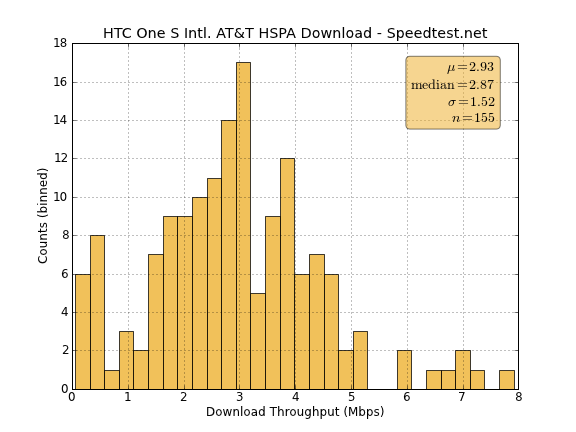

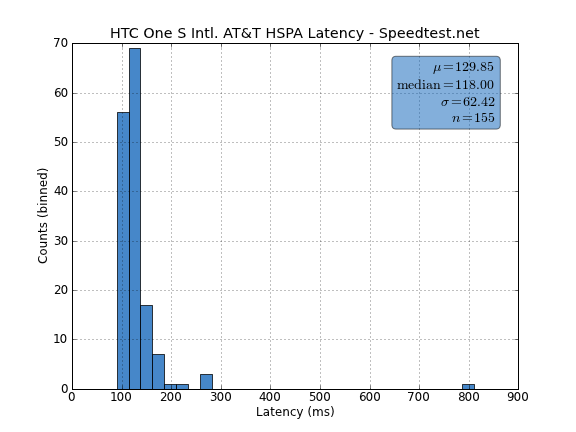
For Qualcomm, the MSM8260A is as much of a stepping stone as the MSM8960, as this is the first time DC-HSPA+ has been integrated into the on-SoC baseband. As I mentioned earlier, the previous solutions were APQ8060+MDM8220 or similar. For T-Mobile, having a number of phones coming up that are compatible with the network’s DC-HSPA+ network is critical to selling its service as being roughly on a similar footing as LTE.
WiFi
Like the HTC One X (AT&T) and XL, the HTC One S uses Qualcomm’s on-SoC baseband for WLAN and BT 4.0. Checking through the boot log, I see the same WCNSS firmware get loaded and initiated which is that WLAN+BT block. The difference between the One X/XL and One S WLAN is that the One S doesn’t include 5 GHz or 40 MHz channel support.
As noted in the above FCC schematic, the WLAN transmit antenna is up at the top in that removable plastic region.
One of our readers pinged me and let me know that reliable iperf ports are now available on Android and iOS, so I’ll be switching over to using iperf for my main WiFi throughput testing instead of the 100 MB PDF. I tested a small number of the phones I’ve got on hand with iperf for comparison.
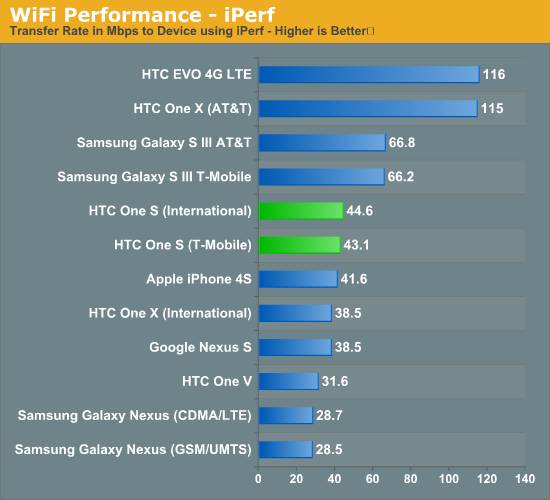
The One X and EVO both have 40HT support on 5 GHz, and thus pull pretty far into the lead. The 20 MHz channel 2.4 GHz devices cluster around 40 Mbps. Unsurprisingly the International and T-Mobile versions are very close.
Speakerphone
I tested speakerphone on the HTC One S using our sound meter 3 inches away from the device on maximum volume. The speakerphone on the One S is underneath the grid of holes on the back at the bottom plastic region. Interestingly enough the devices differed somewhat, though I’d attribute this more to the difference in carrier (AT&T on the International device) than any real difference in loudness between the two.
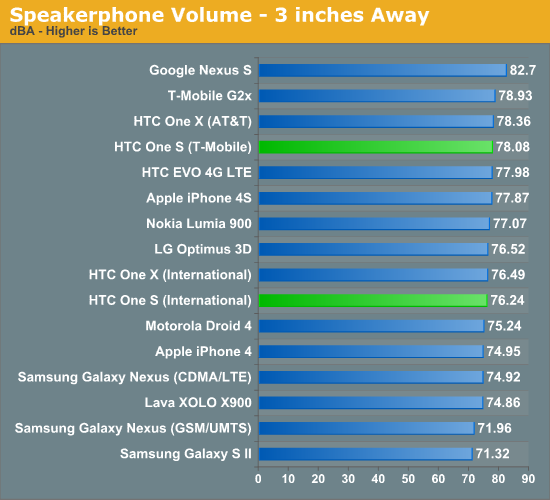
GNSS
I’m starting to sound like a broken record, but just like the One X (AT&T) the One S uses the on-SoC baseband for GNSS (Global Navigation Satellite System). In this case, that means GPS with GLONASS, specifically Qualcomm’s gpsOneGen 8A with GLONASS. I have no problems getting a fast lock even indoors or in an urban environment, and like other combos with GLONASS you can see those satellites pop into use when GPS signal is weak.


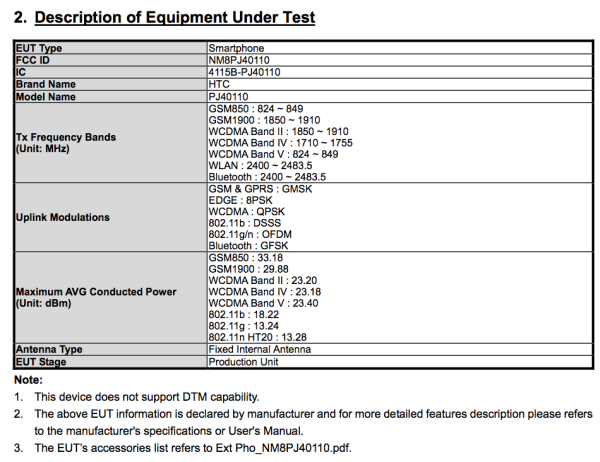
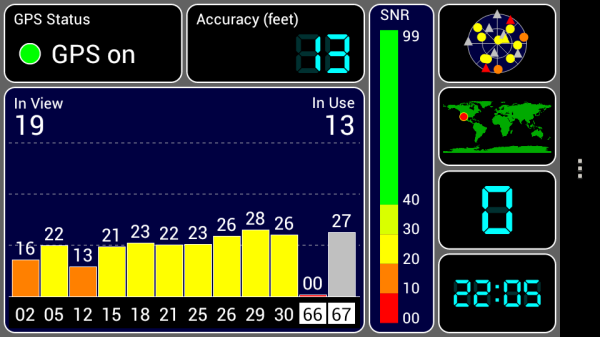








97 Comments
View All Comments
michael2k - Tuesday, July 17, 2012 - link
How is the coming on 10 months old iPhone 4S still getting some of the best battery life?What is going on in Android land?
GrizzledYoungMan - Tuesday, July 17, 2012 - link
Faster processors + LTE.Next.
ltcommanderdata - Tuesday, July 17, 2012 - link
I don't think it's that simple. Yes these recent Android phones have newer, faster Krait SoC which could draw more power compared to the Cortex A9 based Apple A5 in the iPhone 4S, however Krait has the advantage of the latest 28nm process to offset this while the A5 is still on the now more than 3 years old Samsung 45nm process. While the CPU portion of newer SoCs is faster than the A5, the A5's GPU is still faster than the GPUs in every other SoC except the recent Exynos 4412. The A5 is also known to be a large die, high transistor design, which won't do it any favours in reducing power consumption. I don't see a faster processor as being a clear disadvantage to battery life in recent Android phones compared to the iPhone 4S.LTE's contribution also probably isn't huge considering these battery tests are specifically done on 3G and WiFi allowing the LTE portion of the baseband to remain idle and power-gate. While hardware choice contributes, I do think software plays a role since Apple can spend all their time optimizing for one specific hardware configuration whereas Android manufacturers don't really have that luxury.
OCedHrt - Tuesday, July 17, 2012 - link
GPU's are power gated when you're not gaming. A powerful GPU doesn't kill battery life unless all you do is gaming.LTE kills battery life whether you use it or not. Just look at those 4 hour LTE phones from last year. The reason is because the LTE radio is a separate chip - it isn't controlled by the SoC and likely cannot be power gated.
The current generation of 28 nm w/ LTE on chip does have much better battery life - however with Android's multitasking, background syncing, Android simply isn't going to get longer battery life than iPhone 4s unless you turn it all off - and you can turn it off.
Then, as many iPhone 4s users will tell you, many of them also get shitty battery life - it probably depends even more so on how you use it.
amdwilliam1985 - Tuesday, July 17, 2012 - link
"Then, as many iPhone 4s users will tell you, many of them also get shitty battery life - it probably depends even more so on how you use it."Totally agreed, a coworker here with iPhone 4 has battery drained from ~85% to ~55% overnight in "standby" mode.
My SGS2 can go through 2 normal days easily now that I enabled wifi calling and using edge(~10k/s, it's more than enough for texting and syncing).
OCedHrt - Tuesday, July 17, 2012 - link
My One S's wifi calling drains more battery than 3G with strong signal.leexgx - Wednesday, July 18, 2012 - link
what stands out is how can the Motorola Droid RAZR Maxx have such poor web 3G browsing (unless the USA version test was done with LTE then i would cida under stand then) and Wifi Hotspot Battery timethat seems impossible with the 3200mha bat at its disposal i cant see how them results are correct for that phone
what also surprises me is How you manage to get most of these phones to last more then 4-5hrs of constant use (that lacks an secondary Clip on battery like i just got for my HTC One X or an bigger battery like i had for my HTC Desire phone) any phone i see cant seem to last the day of Light use half an day if used in the day unless power is supplied in the day
one thing i hate about the HTC one X an little is Power button really could do with been on the side like the Samsung S3 (phone is to long for 1 hand power button at the top) not sure if its me but phone seems to have been made for Left handed users, the answer and hangup icons have been switched (answer should be on the left and hang up should be on the right) sure that's how my HTC desire had it (guess i should turn on on before i look dumb :) )
other thing as well WiFi and Data go into Forced power saving mode after midnight to about 8am (it turns Wifi off and data Off Even if its Plugged into power after 15 mins screen off, comes back on screen comes on)
OCedHrt - Wednesday, July 18, 2012 - link
I easily get 5+ hours of constant use on my One S. The screen uses up most of the battery, and the on time is always over 5 hours. Sometimes more than 6.name99 - Tuesday, July 17, 2012 - link
Was the coworker using Skype?Skype is notorious for draining the battery rapidly, even while in the background. It's one of the few apps that CAN do so because it's a VoIP app so gets background time (and it basically proves Apple's point that if you allow background apps time, they WILL be written by crappy engineers and they WILL do a crappy job.)
Without wanting to make a big deal about it, I'd point out that under normal circumstances (ie Skype NOT running in the background) my iPhone4 drains by around 5% or less overnight. With Skype running it will drain by 30% or so --- which basically matches what your co-worker was seeing.
OCedHrt - Wednesday, July 18, 2012 - link
Skype is pretty crappy, but there are other, better, VoIP apps available on Android.